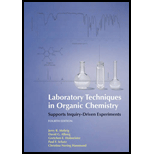
Concept explainers
Interpretation:
The structure of every compound should be deduced along with the chemical shift of their carbon atoms by using additive parameters and NMR signals to their respective atoms should be assigned.
Concept Introduction:
Compounds consist of carbon and hydrogen is known as hydrocarbons. Hydrocarbons are classified as saturated hydrocarbon and unsaturated hydrocarbon. Saturated hydrocarbons are those hydrocarbons in which carbon-carbon single bond is present as carbon is linked with four atoms.
The compounds having similar chemical formula but different structures are known as isomers.
The compounds having similar chemical or molecular formula but different connectivity is known as constitutional isomers.
NMR stands for nuclear magnetic resonance is a technique which is used to characterize organic compounds by identifying frameworks of carbon-hydrogen within the compounds.
Want to see the full answer?
Check out a sample textbook solution
Chapter 23 Solutions
Laboratory Techniques in Organic Chemistry
- The following 1H NMR peaks were recorded on a spectrometer operating at 200 MHz. Convert each into δ units. (a) CHCl3; 1454 Hz (b) CH3Cl; 610 Hz (c) CH3OH; 693 Hz (d) CH2Cl2; 1060 Hzarrow_forwardFollowing is the mass spectrum of bromocyclopentane. The molecular ion m/z 148 is of such low intensity that it does not appear in this spectrum. Assign structural formulas for the cations of m/z 69 and 41.arrow_forwardFill in the Blanks Type your answers in all of the blanks and submit X₂ X² Ω· Determine the number of signals in the ¹H-NMR spectrum of the given compound as well as the ratio of its integrated signals. Number of signals: 7 Integration: 1 You are incorrect You are incorrect X X (express as the lowest whole number ratio from smallest to largest, e.g.,arrow_forward
- In a spectrometer operating at 500.130 000 MHz for 1H, a resonance is found to occur 750 Hz higher in frequency than TMS. What is the chemical shift (on the δ scale) of this peak?arrow_forwardOrganic Chemistry - How many signals would you expect in the 1H NMR spectrum of HOCH2CH2CH2CH2OH?arrow_forward3. Identify C-Cl stretching peaks in CDC13 and CHC13 spectra. Do these peaks have exactly the same frequencies for both compounds? Explain your answer. 4. Is the C==O stretching frequency the same for acetone and deuterated acetone? Explain your answer. 5. Identify C==O overtone in acetone spectrum which corresponds to the transition from ground level, n=0, to the second excited level, n=2.arrow_forward
- In a 300 MHz NMR spectrometer, A) what is the Larmor frequency in MHz of a 15N nucleus? g H = N 26.752; g = 2.7126; B) Using the same NMR instrument, suppose that a 13C nucleus from a sample generates a signal which has a frequency of 11,250 Hz higher than that from the carbons in TMS. What is the chemical shift of that carbon atom from the sample? A) 30 MHz; B) 0.15 ppm OA) 25 MHz; B) 0.35 ppm A) 35 MHz; B) 0.30 ppm OA) 25 MHz; B) 0.55 ppmarrow_forwardA student needs to prepare a ¹H NMR sample for an organic compound soluble in chloroform (CHCI3). The student cannot use CHCI 3 as the solvent for the sample, but rather uses deuterated chloroform (CDC13) because: O CDC13 is more polar. O CDC13 will not produce a signal in the ¹H NMR spectrum, and therefore will not mask the signals of the compound. O The compound will be more soluble in CDCI 3. O CDC13 is cheaper than CHCI 3.arrow_forwardThe 13C NMR spectrum of ethanoic acid (acetic acid) shows a quartet centred at δ = 21 with a splitting of 130 Hz. When the same spectrum is recorded using proton decoupling, the multiplet collapses to a single line. Another quartet, but with a much smaller spacing, is also seen centred at δ =178; this quartet collapses when decoupling is used. Explain these observations.arrow_forward
- Choose the alkene or alkenes that would produce two 1H NMR doublets with a J = 1 to 2 Hz, and ones that would produce one unique 1H NMR signal, and ones that would produce two 1H NMR doublets with a J = 15 to 18 Hz.arrow_forwardIdentify and explain the IR absorption characteristics of the unknown C6H14O in the 1400 to 4000 cm-1 range. Then identify the class of the unknown compound C6H14O. At the broad peak I believe it is either an alcohol & phenol or an amine. For the second peak i think it is an alkane.arrow_forward(a) What would be the chemical shift of a peak that is observed at 655.2 Hz from the reference tetramethylsilane (TMS) recorded using a 90 MHz spectrometer ? (b) At what frequency would the chemical shift of chloroform (CHCl3, δ = 7.28 ppm) occur relative to TMS on a spectrum recorded on a 300 MHz spectrometer? (c) At what frequency and chemical shift would the signal for chloroform occur when using a 1 GHz NMR spectrometer?arrow_forward
 Organic ChemistryChemistryISBN:9781305580350Author:William H. Brown, Brent L. Iverson, Eric Anslyn, Christopher S. FootePublisher:Cengage Learning
Organic ChemistryChemistryISBN:9781305580350Author:William H. Brown, Brent L. Iverson, Eric Anslyn, Christopher S. FootePublisher:Cengage Learning
 Principles of Instrumental AnalysisChemistryISBN:9781305577213Author:Douglas A. Skoog, F. James Holler, Stanley R. CrouchPublisher:Cengage Learning
Principles of Instrumental AnalysisChemistryISBN:9781305577213Author:Douglas A. Skoog, F. James Holler, Stanley R. CrouchPublisher:Cengage Learning


